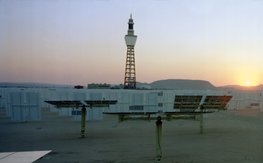Reviewing last week's solar energy news
 There was mixed news for the solar industry, largely because of international market dynamics. Elsewhere, the solar thermal industry gained some steam and efforts to educate the public on solar increased.
There was mixed news for the solar industry, largely because of international market dynamics. Elsewhere, the solar thermal industry gained some steam and efforts to educate the public on solar increased.
First of all, SunPower Corp. (NASDAQ: SPWRA, SPWRB) announced losses of $147.9 million in the second quarter of 2011. That’s compared to a net loss of $2.1 million for the first quarter of the year and a net loss of $6.2 million for the second quarter of 2010. The losses were attributed to weakness in the European market. The results are similar to those reported by the U.S.’ other major solar manufacturer/installer, First Solar (Nasdaq: FSLR).
To address the issue, SunPower said it is refocusing its efforts in the European market on residential and commercial deployment. It’s also increasing its production for the North American market with a Mexicali, Mexico production facility that will build SunPower modules and racking equipment for the market.
First Solar reported weaker earnings for the second quarter and projected stronger earnings for the second half of 2011. And it looks like that will happen. For instance, Pacific Gas and Electric Co. (NYSE: PCG) reached a power-purchase agreement with Sempra Generation for the planned second, 150-megawatt (MW) phase of Sempra’s Copper Mountain Solar project, which will use First Solar modules. And the Bureau of Land Management is accepting public comment on First Solar‘s proposed 300-megawatt Stateline Solar Farm on the California-Nevada border.
The big issue behind the lowered prices is a glut of photovoltaics. But that glut is leading to lower module prices, which will help, for instance, the amount of installed photovoltaics in the U.S. to double in 2011 over 2010. That’s according to the new "United States PV Market Report" from Solarbuzz. The report found that U.S. demand will make the U.S. the third largest photovoltaic market in 2011.
Meanwhile two different parts of the solar thermal world made the news this week. EnviroMission’s solar updraft tower technology, which will likely create the tallest solar structures in the world, found a construction partner in Hensel Phelps Construction. The company is providing services free-of-charge to EnviroMission until it finalizes funding for its first 2,500-foot tall, 200-megawatt solar chimney, which will be built in Arizona.
Another solar thermal tower manufacturer that uses heliostats to superheat water into steam for power generation, BrightSource Energy, Inc., introduced its new solar thermal storage technology. The SolarPLUS thermal storage technology will allow the company’s tower systems to produce electricity generated from steam even without the sun. It joins a growing number of solar thermal or concentrating solar power companies to use molten salts for energy storage.
In one key aspect environmentalists and solar companies are in agreement. The adoption of more solar means reducing our reliance of fossil fuels and other polluting technologies. But beyond that, environmentalists and the solar industry don’t always see eye-to-eye. However, the two sides came together to protect the San Joaquin kit fox and giant kangaroo rats in California while enabling SunPower and First Solar to build their planned mega-solar farms. Under the agreements, the companies expanded preservation efforts, and the Sierra Club, Defenders of Wildlife and the Center for Biological Diversity agreed not to take any legal actions regarding the projects on sensitive lands in development in San Luis Obispo County, Calif.
HelioPower introduced a fun, educational video “Solar Overload” on YouTube that shows just how many household appliances can be powered by a rooftop system in the daytime. And it’s a lot. The 4-kilowatt photovoltaic array at the home of Scott Gordon, HelioPower’s vice president of residential sales, could power all the home’s lights, its two fridges, two DVRs, five ceiling fans, an attic fan, a computer and a monitor, while still feeding back to the grid.
Dow Corning is now a sustaining, educational sponsor for 2011’s U.S. Solar Decathlon. The company will develop materials for middle school students, including class curriculums.
Image courtesy of NREL.



